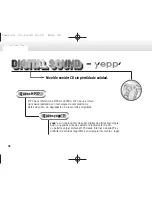
48
Technical description
OVERSAMPLING
The audio data on CDs and DVDs is stored at a sampling
rate of 44.1 or 48 kHz - i. e. for each second of music
44.100 or 48.000 sampled values are available for each
channel. In the
DVD 1235 R
the audio data read from the
DVD or CD is „multiplied“ to a higher sampling rate
(384 kHz) before it is converted back into analogue music
signals. This process delivers a significantly better, more
finely graduated signal to the converter, which can then
be converted with correspondingly higher precision.
The
DVD 1235 R
provides two different algorithms for up-
sampling CD audio signals: the standard FIR filter and the
short FIR filter. During playback you can switch between
them at any time using the
-button.
The short FIR filter produces a more accurate signal packet,
and therefore sounds slightly more dynamic.
The standard FIR filter suppresses background noise more
effectively, and is primarily recommended for vocal and
chamber music.
The
DVD 1235 R
therefore provides a means of matching
the
system’s
reproduction
characteristics
to
the
requirements of the recording and your own personal
preferences.
Standard OVS FIR filter
The long FIR filter is the standard oversampling process
in digital technology, offering extremely linear frequency
response, very high damping, linear phase charac-
teristics and constant group delays. The disadvantage is
the pre- and post-echoes which are added to the signal.
These „time range errors“ tend to affect the music
signal’s dynamics, precision and naturalness, and reduce
spatial orientation.
Frequency response and transient characteristics of
the long FIR filter
OVS 1
(short
FIR
filter)
Shortening the filter (lower coefficient) reduces the time
range errors, albeit combined with a slight loss of linearity
in the frequency range and damping per-formance.
Frequency response and transient characteristics of
the short FIR filter
Summary of Contents for 1235 R
Page 1: ...V1 0 Order No 9103 0330 USER MANUAL DVD 1235 R...
Page 2: ...2...
Page 9: ...9...
Page 17: ...17...
Page 20: ...20...
Page 21: ...21 Menu TOOLBAR overview...
Page 24: ...24...
Page 25: ...25 Menu Preferences overview...
Page 29: ...29 Menu SETUP overview...
Page 34: ...34...
Page 43: ...43...







































